For many, the first real bond with nature began through art – whether drawing trees in kindergarten, crafting with fallen leaves, or shaping sand into castles by the sea. These creative moments helped us see the deep connection between people and the natural world.
Now, as ecological issues grow, artists around the world are reigniting that same sense of wonder through their environmental artwork.
The Deep Roots of Environmental Art
Before terms like ‘climate change’ existed, our ancestors expressed their bond with the earth through art. From ancient cave paintings depicting local wildlife to Indigenous art traditions that honour the sacred relationship between humans and nature, art has always been our way of understanding the environment and preserving the natural world. This legacy continues today through environmental art, a movement that combines artistic expression with ecological awareness.
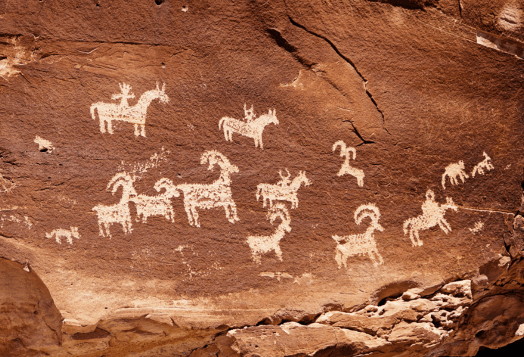
What’s Eco-Consciousness in Art
Environmental art, or eco-art, blends creativity with environmental advocacy. Artists use natural elements like soil, leaves, and stones or repurpose discarded materials to craft works that spark awareness.
These artworks frequently appear at unexpected locations, challenging traditional perceptions and encouraging viewers to engage deeply with the message conveyed.
When Art Sparks Action
In 2018, a massive installation appeared on a Philippines beach: a 50-foot-long blue whale made from ocean plastic. Greenpeace Philippines used this art to highlight how microplastics pollute our food and harm marine life.
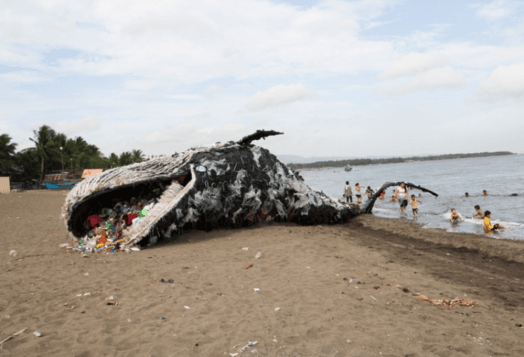
Image credit: My Modern Met
The power of environmental art lies in its ability to transform abstract statistics into visceral experiences. When Robert Smithson created his monumental ‘Spiral Jetty’ in Utah's Great Salt Lake, he didn't just make a sculpture – he created a living barometer of environmental change.
As lake levels fluctuate due to climate change and water usage, the artwork emerges and submerges, telling the story of our changing environment in a way that resonates more deeply than any scientific report could.
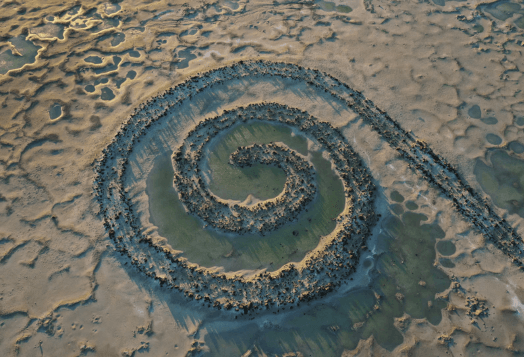
Image credit: Jeffrey D. Allred, Deseret News
Pioneers Who Shaped the Movement
The environmental art movement has been shaped by visionaries who saw the creative potential in nature's own materials.
Andy Goldsworthy began his artistic journey by playing with snow in his Yorkshire hometown and now creates ephemeral installations that capture nature's transient beauty. His work reminds us of childhood moments spent arranging leaves or stacking stones, while simultaneously addressing serious themes of environmental change and human impact.
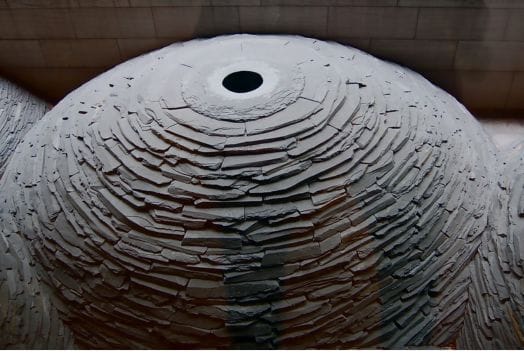
Image Credit: Singulart
(“Roof” is a notable installation by Andy Goldsworthy, created in 2004, showcasing his unique art process that blends the natural with the man-made. This site-specific artwork transforms the concept of a roof by using local materials like mud, grass, and stones, highlighting the connection between art and the environment while prompting reflections on human impact and the importance of environmental protection.)
Nils-Udo has been shaping nature into art, creating stunning landscape installations across the world. His work blends plants, earth, and space, turning ordinary places into breathtaking scenes that make people pause and reflect. By working with nature’s own materials, he reminds us of our deep connection to the environment, making us see the world—and our place in it—a little differently.
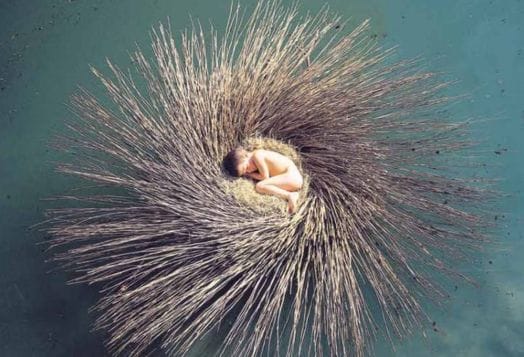
Image Credit: Eco Disciple
Ways To Turn Creativity into a Voice for Nature
The Power of Recycled Materials
Every discarded bottle, forgotten newspaper, and abandoned metal scrap holds artistic potential. El Anatsui, who grew up watching his grandmother weave Kente cloth in Ghana, transforms thousands of discarded bottle caps into shimmering tapestries that recall both traditional African textiles and the modern crisis of waste. His work demonstrates how artists can turn environmental problems into opportunities for beauty and reflection.
Public Installations That Change Perspectives
The "Great Elephant Migration" installation placed 100 life-sized elephant sculptures crafted from invasive plant species throughout London's parks. Each sculpture told the story of habitat loss and human encroachment, while the use of invasive plants highlighted how human activities disrupt natural ecosystems. The project reconnected urban residents with wildlife conservation issues while creating spaces for community gathering and reflection.
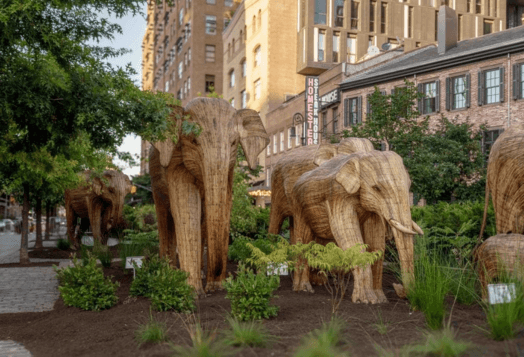
Image Credit:Artnet
Digital Art for a Connected World
Modern technology offers new ways to explore our relationship with nature. Digital artists create immersive experiences that help urban dwellers reconnect with the natural world they've lost touch with. Virtual reality installations let viewers experience disappearing ecosystems, while social media campaigns unite global communities around environmental causes.
Building Community Through Environmental Art
1. Local Initiatives That Make a Difference
Community gardens represent one of the most successful intersections of art and environmental activism. In Detroit, abandoned lots have been transformed into living art installations where sculptures made from reclaimed materials stand amid flourishing vegetable gardens. These spaces provide food, beauty, and gathering places while teaching younger generations about sustainability through hands-on experience.
2. Educational Programs That Inspire
Schools worldwide are incorporating environmental art into their curricula, recognizing its power to teach complex ecological concepts through creative expression. Students who struggle with scientific concepts often grasp environmental issues more readily when they engage with them creatively, whether by drawing, creating collages from beach cleanup materials or designing posters about endangered species.
Corporate Partnerships with Purpose
Forward-thinking companies are collaborating with artists to raise awareness and drive change.
Patagonia's partnership with photographers and filmmakers has produced powerful documentaries about environmental conservation.
Truly Tribal promotes traditional Indian art forms such as Phad painting and Pattachitra that utilize sustainable practices. Their focus on sustainability aligns with promoting awareness about environmental issues through traditional art forms.
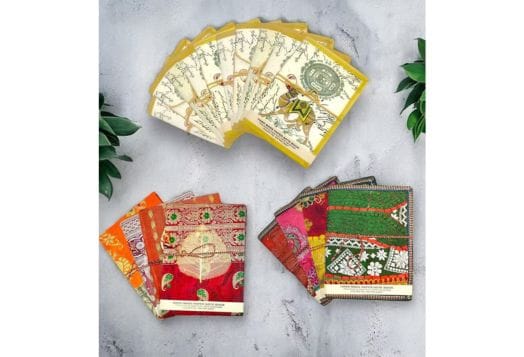
Image Credit: Truly Tribal
Government Initiatives Making an Impact
India's Swachh Bharat Abhiyan (Clean India Mission) has embraced art as a tool for environmental education. Street artists transform public walls into powerful messages about waste management and water conservation, while the Namami Gange Programme uses traditional and contemporary art forms to promote the restoration of the Ganges River ecosystem.
Your Role in the Movement
The environmental art movement needs voices from every community and perspective. Start by observing the natural world in your daily life – notice the patterns in tree bark, the flow of water in local streams, and the flight paths of birds in your neighbourhood.
Consider how you might translate these observations into art that speaks to your community's environmental concerns. You might photograph the changing seasons in a local park, create watercolor art or sculptures from beach cleanups, or organize a community mural project about local wildlife. The key is to start with what moves you and let your artwork grow naturally from there.
Art as a Catalyst for Change
As we face unprecedented environmental challenges, the role of art in inspiring action becomes increasingly crucial.
The next time you come across a piece of environmental art – whether it's a sculpture made from ocean plastic, a mural about local wildlife, or a digital animation about climate change – remember that you're experiencing more than just an artwork.
You're participating in a global conversation about our relationship with the planet, and you have the power to add your own voice to that dialogue.
The earth needs every voice, every vision, and every creative act in the ongoing work of environmental protection and restoration.




